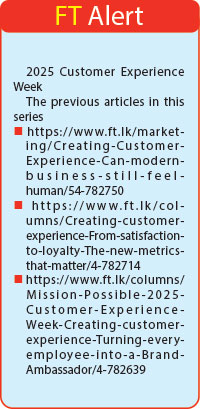Friday Oct 10, 2025
Friday Oct 10, 2025
Friday, 10 October 2025 00:01 - - {{hitsCtrl.values.hits}}
 Employee engagement refers to one’s emotional and intellectual involvement in unique value creation. It is a positive attitude held by employees towards the organisation and its values. This becomes evident when an employee demonstrates a business sense supported by the right competence to perform the job, along with timely commitment. Employee engagement is a crucial factor in establishing a customer experience culture in any organisation.
Employee engagement refers to one’s emotional and intellectual involvement in unique value creation. It is a positive attitude held by employees towards the organisation and its values. This becomes evident when an employee demonstrates a business sense supported by the right competence to perform the job, along with timely commitment. Employee engagement is a crucial factor in establishing a customer experience culture in any organisation.
When service quality drops, leaders often look at training, systems or policy. Too often, they overlook the human factor — employee engagement. The truth is simple: disengaged employees create disengaged customers.
Purpose drives performance
A feeling of psychological connection with the organisation generates Positive Energy Transformation (PET) across the entity. This creates a positive atmosphere in the workplace, where even the most routine tasks are performed with enthusiasm. When staff have a clear understanding of the real purpose for which the business exists, they demonstrate engagement. Thus, employee engagement drives performance.
Staff should be given clear directions and made to feel that they are a vital part of the business. When employees are clear about their mission and understand the bigger picture of the organisation’s existence, they put their heart and soul into delivering outputs that achieve stakeholder delight. Engaged employees experience positive emotions which broaden their thinking, leading them to become more focused and absorbed in their work. This means there is a direct correlation between employee engagement and employee performance.
 How can we achieve employee engagement?
How can we achieve employee engagement?
Employees are the bloodstream of any business and its most valuable asset. They are the custodians of the company’s brand value. Training is one of the vital human resource management practices that positively affects the quality of workers’ knowledge, skills and attitudes. It can make a significant impact on performance. Employees demonstrate engaged behaviour when they are given training and development opportunities.
The right training is an investment in an employee’s career because it creates higher job satisfaction, enhances performance and increases loyalty to the organisation. The end result is the creation of a positive and productive culture. When an organisation has a highly motivated set of employees, they tend to work with the least amount of supervision.
Constructive training on employee engagement is a primary role of managers. The following are a few steps managers can practise:
1.Identify specific and actionable training requirements of staff
The respective line manager should assess the current level of employee engagement and identify the gaps to be fulfilled, whether they are technical or soft skills development. Staff should never be sent for training merely for the sake of doing so or to tick a box. Every training initiative must have a constructive end in mind.
2.Offer programs tailored to meet the exact needs of staff
Design appropriate learning programmes with specific objectives that align with organisational goals and employee career aspirations. Different programmes may need to be designed and facilitated depending on the level of stakeholder interaction each employee has. Remember, no trainer is effective until he or she understands the exact requirement and current status of the trainee.
3.Obtain a realistic action plan written by the participant
After completing a training programs, the participant should immediately agree with their line manager on specific action points to implement in their current role. These should fall broadly under three areas:
(a) New initiatives – start practising new learning.
(b) Stop doing – discontinue activities realised to be of no value.
(c) Continue doing – maintain practices that continue to add value to stakeholders.
4.Demonstrate line managers’ involvement in progression
Monitor the behavioural changes of staff following their participation in the programme. Demonstrate the line manager’s willingness and involvement in any policy modifications and process improvements that facilitate smoother performance for participants. For example, empowering staff to take immediate decisions may require a policy modification. Similarly, enhancing delivery speed may require process improvements supported by staff and systems.
5.Recognise, reward and publicise best practices
Humans need recognition, and it is a powerful source of inspiration. Employees’ efforts in achieving specific tasks should be genuinely noticed and recognised. Staff must be assured of a career path and given confidence that performance alone will be considered for progression within the organisation. All achievements and best practices should be shared across the organisation.
6.Get regular feedback from staff
Managers must believe that the best ideas do not necessarily come from the top. Those closest to the fire feel the heat the most. The best source of innovation is the people who serve customers daily. They know the sticking points and hear the complaints first. Holding regular friction audits — short sessions where front-line staff identify common pain points — can reveal opportunities that management may not see. These can be treated as valuable learning opportunities.
7.Maintain work-life balance
Managers should walk the talk in emphasising the importance of work-life balance. Employees who feel overwhelmed by their workload or who lack balance may struggle to stay engaged. Training on work-life balance and stress management can help employees prioritise their responsibilities, set boundaries and maintain a healthy balance between professional and personal life.
(The writer is a sought-after ‘Customer Experience’ specialist in Sri Lanka. Over the last three decades he has conducted nearly 3,500 inspirational and educational programs for over 800 organisations in 11 countries. His work can be seen at www.dhammikakalapuge.com.)